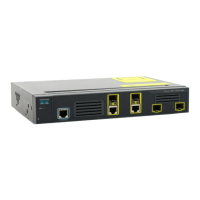Data Sheet
© 2008-2009 Cisco Systems, Inc. All rights reserved. This document is Cisco Public Information. Page 5 of 21
The Cisco CNS 2100 Series network device allows service providers to effectively manage a
network of Cisco ME 3400 Series and other Cisco IOS Software devices. It is a completely self-
contained unit that includes a task-oriented web GUI, a programmable Extensible Markup
Language (XML) interface, configuration template management, and an embedded repository.
Network operators can use the web GUI to quickly turn existing Cisco IOS Software CLI
configuration files into reusable templates. The Cisco CNS 2100 Series integrates easily into
existing customer OSSs or business support systems (BSSs); it can provision systems with its
external repository support and the event-based Cisco IOS Software XML interface that effectively
“workflow-enables” deployment of Cisco devices.
Cisco ISC is a family of cost-saving intelligent network management applications that provide
automated resource management and rapid profile-based provisioning capabilities. It helps service
providers offering Layer 2 VPN services with provisioning, planning, and troubleshooting features
essential to manage the entire lifecycle. Management features such as policy-based VPN,
management VPN, and QoS provisioning help reduce the cost of deploying Layer 2 VPN services
and help guarantee the accuracy of service deployment.
Service providers can also manage the Cisco ME 3400 Series using SNMP versions 2 and 3. A
comprehensive set of MIBs is provided for service providers to collect traffic information in the
Cisco ME 3400 Series.
Ethernet Operations, Administration, Maintenance, and Provisioning
The advent of Ethernet as a metropolitan and wide-area networking technology has accelerated
the need for a new set of operations, administration, maintenance, and provisioning (OAM&P)
protocols. Service provider networks are large and complex with a wide user base, and they often
involve different operators that must work together to provide end-to-end services to enterprise
customers. To answer enterprise customer demands, service providers must reduce the mean
time to repair (MTTR) and increase service availability. Ethernet OAM&P features address these
challenges and enable service providers to offer carrier-grade services.
The Cisco ME 3400 Series supports industry-standard OAM&P tools including IEEE 802.1ag
Connectivity Fault Management and Ethernet Local Management Interface (E-LMI) protocol. IEEE
802.1ag tools to monitor and troubleshoot end-to-end Ethernet networks allow service providers to
check connectivity, isolate network issues, and identify customers affected by network issues. E-
LMI protocol, developed by the MEF, enables service providers to automatically configure the
customer-edge device to match the subscribed service. This automatic provisioning not only
reduces the effort to set up the service, but also reduces the amount of coordination required
between the service provider and enterprise customer. In addition, the Cisco ME3400 series
supports the IEEE 802.3ah Ethernet in the First Mile standard for monitoring, remote failure
indication, loopback, and OAM discovery on the link between the customer equipment and the
service provider network.
Furthermore, the Cisco ME 3400 Series supports the ITU-T standard Y.1731, which provides fault
management and complements the IEEE 802.1ag functionality.
Resilient Ethernet Protocol
Resilient Ethernet Protocol (REP) is a Cisco proprietary protocol that provides an alternative to
Spanning Tree Protocol (STP) to control network loops, handle link failures, and improve
convergence time. REP is designed to meet service providers’ requirement for a fast and
predicable reconvergence solution for Layer 2 networks. In addition, REP also supports VLAN load

